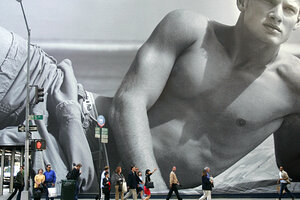Abercrombie & Fitch: What's wrong with selling just to 'cool people'?
Abercrombie & Fitch CEO Mike Jeffries set off a cultural backlash when said that his company is primarily interested in 'good-looking people.' But the company is jealously guarding its brand, even as the market for plus-size teens grows.

Pedestrians walk pass a giant display of an Abercrombie & Fitch ad in May 2005, in New York City. The retailer may be slashing prices to compete with discount fashion giants such as Forever 21 and H&M.
Kiichiro Sato/AP/File
Abercrombie & Fitch, one of the top sellers of young adult clothing in America, is again mired in controversy, this time over its refusal to offer plus-size clothes for teens.
The retailer, which operates 295 stores across the US, is the target of several online protests responding to comments made in a 2006 interview by its CEO, Mike Jeffries, who said he is primarily interested in marketing to “the cool kids” and “good-looking people.”
“We go after the attractive all-American kid with a great attitude and a lot of friends. A lot of people don’t belong [in our clothes], and they can’t belong. Are we exclusionary? Absolutely. Those companies that are in trouble are trying to target everybody: young, old, fat, skinny. But then you become totally vanilla.”
The remarks, which originally ran in Salon, were republished this month by Business Insider in a wider story about marketing to plus-size teenagers. The article title, “Abercrombie & Fitch refuses to make clothes for large women,” didn’t help soften things either.
Mr. Jeffries says the quotes were taken out of context. In a Facebook posting last week, he said that while he regretted his word choice and is “strongly committed to diversity and inclusion,” his brand is “aspirational” in that “targets its marketing at a particular segment of customers.”
This week, a spokesperson for the company told NBC News that, “we sincerely regret and apologize for any offense caused by comments we have made in the past which are contrary” to “diversity and inclusion.”
Those gestures have not swayed critics who say the company is creating damaging images for teenagers both through its marketing images, which typically show svelte models in provocative poses, and its policy of not offering clothing for women above size 10.
The controversy is not the first for the retailer. In the past, it was criticized for photo shoots that showed young teenagers in positions that suggested they were participating in group sex, along with ad copy in its catalog that some ridiculed as soft pornography. The company is also remembered for a T-shirt line, later recalled, that mocked Asians
An online protest that asks the company to “start making clothes for young people of all shapes and sizes” has collected more than 71,000 signatures, and a viral video on YouTube that asks people who own clothing made by the company to donate them to the homeless, has more than 7.2 million views. Other protests, such as a campaign by plus-size blogger Jes Baker, have entered the spotlight for presenting arguments on why catering to the needs of plus-size youth matters.
The plus-size market for teenage clothing was largely ignored until the recession, says Marshal Cohen, chief retail analyst at the NPD Group. Once considered a niche, with growth potential in the single digits, the market is now more desirous for companies that need to make their bottom line at whatever cost. That can mean expanding their clothing lines with fashion-forward products that appeal to the growing population of plus-size teens.
Swedish retailer H&M, denim retailer Lucky Brand, and The Limited all created specialty brands targeting teenage girls who are plus-sized. Even reality television stars the Kardashian sisters are getting into the game; their plus-size brand Kardashian Kurves, launched this year at Sears.
“We’re just getting bigger and bigger and bigger so the number of people entering into plus-size continues to get bigger. There’s always been the opportunity, but never one that somebody’s tried to capitalize on before,” says Mr. Cohen. “What you have now are consumers desperately seeking fashion for their size and retailers saying, ‘We get it, we’ll offer you something.’ ”
Research that shows that obesity is particularly prevalent among children and teenagers. The Centers for Disease Control and Prevention (CDC) says that in 2009-10, 17 percent of US children and adolescents were reported as obese, which is three times the obesity rate just one generation ago. The age group most likely to be obese: those aged 12 to 19.
The NPD Group, a market research firm in Port Washington, N.Y., says that clothing retailers have mostly accommodated this trend by offering larger clothing sizes – since 1960, for example, the average dress size increased from size 8 to 14. Two-thirds of women identify themselves as “special-sized,” according to NPD, which means there is more demand for this type of clothing in the women’s clothing market, valued at $111 billion in 2012.
Cohen says that despite the opportunity that others have capitalized on, it is unlikely that Abercrombie & Fitch will do a mea culpa and launch a plus-size brand.
“Abercrombie from Day 1 said, ‘We are about the iconic image of the quintessential affluent teen' … and they want to maintain that certain imagery at all cost,” he says. Switching gears in response to the current controversy may appease critics, he adds, but it will ultimately dilute what gave the brand value in the first place.
“If they alter their course, they’ll do more damage than good,” Cohen says. “If you try to be something for everybody, you end up being nothing for everyone.”

